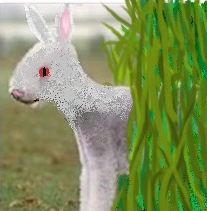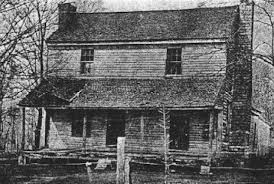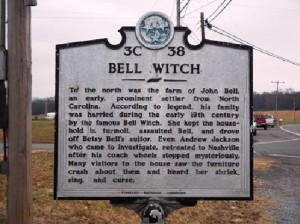“I am a spirit who was once very happy but have been disturbed and am now unhappy.”—the Bell Witch
A little over a century before Gef came along, there was another highly unusual case that is widely regarded as being the work of a poltergeist, but this one had a very different flavor. The Bell Witch is the only known case, or at least the only case known to me, of an alleged poltergeist possibly killing someone. Other than that, there are numerous similarities to Gef, as well as similarities to many other more typical poltergeist disturbances.

In 1817, a farmer in Robertson County, Tennessee named John Bell saw an unusual animal in his corn field. It had the body of a dog and a head like a rabbit, similar to an esquilax, but in this case with a dog’s body. Bell shot at it several times and the animal vanished. Supposedly, he thought no more about it, though that’s hard to believe. Shortly thereafter, the family started hearing scratching and thumping sounds against the side of the house. Things escalated quickly from there.
Before long, the children (there were nine of them!) began to complain that something was pulling the covers off of them in bed. They also began hearing noises like someone choking or gasping for air. All of this was pretty minor stuff, but when things started moving around on their own, it really got their attention. They also started to notice that these things only happened when Betsy, the Bell’s 12-year-old daughter, was around. The next three years were complete bedlam for the entire Bell family.
After about a year of these disturbances, the covers continued to be pulled off of the sleeping children, but now they were getting slapped in the face by an invisible hand if they tried to stop it. John Bell invited neighbors over to check out the disturbances for themselves. James Johnston and his wife spent the night there and got much the same treatment as the Bells. Accounts vary as to what exactly happened, but when Johnston told the “ghost” to knock it off, possibly invoking the name of God, the rest of the night was event free. That didn’t last. Whatever Johnston said, he seems to have really pissed this thing off, and it took it out primarily on Betsy. She started having her hair pulled and getting her face slapped almost constantly, so hard that it left welts and red handprints on her cheeks. When she was sent to stay with neighbors, things at the Bell house became quiet, but Betsy continued to get smacked around. Now that’s a poltergeist!
Though Betsy was the main focus of most of the hostility at this point, others were not completely ignored. Visitors to the Bell home were slapped, and the other Bell children had stones thrown at them as they walked home from school, usually from the same thicket. The stones didn’t harm the children. As is common in poltergeist cases, flying objects seem to lose their momentum as they strike people and fall harmlessly to the ground. The slaps, however, still stung like hell. Your guess is as good as mine as to why that would be. Balls of white light were seen floating around the area at night and supposedly still are to this day.
The next phase of whatever was going on there was that the gasping noises changed over to a whistling sound and then to an actual voice. In his book Poltergeist, Colin Wilson points out that this is also common in these types of cases. It’s as if the source of the disturbance has to figure out how to speak and starts off with more basic vocalizations, not unlike the preliminary stage of toddlers first learning to talk. Once the entity started to speak, the primary focus of its antagonism switched from Betsy to her father, though Betsy still remained a secondary target of its malice. It also seems clear that Betsy was the source of its power. As soon as it started talking, Betsy began suffering from fatigue, shortness of breath and fainting spells. About this same time, John Bell’s tongue swelled up and his jaw began aching so badly that he would sometimes go more than a day without eating.
At the beginning, the voice sounded to the family like the muffled voice of an old woman singing hymns, also an early favorite of Gef’s. As it became louder and clearer, the voice first claimed to be a spirit that was once happy but wasn’t anymore. A short time later it said that it was the spirit of a Native American, and then that it had been a witch named Kate Batts. The “witch” told John Bell, who she called Old Jack, that she would torment him until she finally killed him.
Four other entities also began speaking. One calling itself Blackdog had a harsh, masculine voice. Another that said that its name was Jerusalem sounded like a little boy. The other two, Cypocryphy and Mathematics, sounded “delicate and feminine.” They were all apparently Dartmouth alums because they frequently slurred their words and filled the house with the smell of whiskey. That seems to be about all that anyone bothered to record about them.
Although the witch clearly hated John Bell, it seemed to begin to like the rest of the family most of the time. It even lightened up on Betsy. One year on her birthday, the voice suddenly announced that it had a surprise and, allegedly, caused a basket of fruit to materialize that included oranges and bananas, items which were not readily available in Tennessee at the time.  Once when some of the Bell children were sitting on a sled, she told them to hold tight and then pulled it around the house three times “at great speed,” which they doubtless enjoyed. Another time, when Betsy and some other children were playing in what has come to be known as the Bell Witch Cave, a little boy became stuck between some rocks. The now familiar voice announced “I’ll get him out,” and the boy felt two hands grab him and pull him free.
Once when some of the Bell children were sitting on a sled, she told them to hold tight and then pulled it around the house three times “at great speed,” which they doubtless enjoyed. Another time, when Betsy and some other children were playing in what has come to be known as the Bell Witch Cave, a little boy became stuck between some rocks. The now familiar voice announced “I’ll get him out,” and the boy felt two hands grab him and pull him free.
The witch seemed to be the fondest of John’s wife Lucy. Once when she was sick, the witch did its best to comfort her with the words “Luce, poor Luce” and then showering her with hazelnuts for reasons that are far from clear to the uninitiate. It would seem that even a sometimes malevolent entity knows that any woman who has been through childbirth nine times before the invention of the epidural deserves a break, although it might have had a more tragic and pitiable reason for its compassion.
It has been speculated upon that this entity, whatever its nature and origin, may have had good reason to sympathize with Lucy, hate John, and have an alternately hostile and benevolent attitude towards Betsy. You don’t have to be a family therapist or a social worker to figure out that both Lucy and Betsy may have been victims of abuse. In Betsy’s case, it wouldn’t be unusual for the victim of the sort of abuse that she may have endured to feel not only helplessness, but also guilt and anger, which could explain why she was the recipient of both sympathy and aggression. The “witch” could have been created by her unconscious mind as a way of getting back at her father while her feelings of shame caused her own creation to punish her as well. The general consensus about poltergeists, although I have my doubts, is that they are unconscious manifestation of psychokinesis generated by the person that they are attached to. That seems a nice paranormal version of a Freudian interpretation in this case, but there are some holes in it.
The first flaw in this theory is Betsy’s aborted engagement. She had become involved with a young man named Joshua Gardner whose family owned a nearby farm. Both families were said to be in favor of their marriage, but the witch was firmly against it. She managed to end the relationship at least in part by humiliating both of them by revealing their most embarrassing secrets to the other, usually when they were together. Had Betsy’s father molested her, the witch would almost certainly have made it known, but there’s no evidence that this was the case. Of course, there may be lines of decency that even some poltergeists won’t cross, but that isn’t the norm. There have been numerous other cases of poltergeists revealing the most embarrassing secrets of anyone and everyone present, apparently just for their own amusement. Many times these accusations are known or are later proven to be blatant lies. The idea that Betsy unconsciously created the witch would explain why the manifestations followed her to the neighbors’ house, but not why the witch later returned to the farm years after Betsy had married and moved away.

Meanwhile, back at the farm, things were getting really bad for John. He spent the last year of his life under almost constant attack. He was slapped mercilessly and his face would often contort as if being tugged around by invisible fingers. When he went outside, his shoes would fly off. No sooner would he put them back on than they would fly off again. He also seems to have been sick a lot during this time, and when he was, the witch would taunt him for hours in a voice that could be heard all over the farm. On the morning of December 19, 1820, the family discovered that John had slipped into a catatonic state sometime during the night. John Jr. found a vial containing a smoky liquid in the cupboard, and the witch announced that she had put it there. She said that it was poison and that she had given some to “Old Jack” and he would be dead soon. When the doctor arrived, they put a drop of it on the cat’s tongue.* It went nuts and spun around the room for a few seconds and then died. John Bell died the next day and the witch rejoiced mightily. According to one source, as people were leaving the funeral, the witch began laughing and singing and kept it up until every last person had gone. She really didn’t like that guy.
After John’s death, the disturbances around the house decreased dramatically. John Jr. seems to have been the only one that the witch ever talked to anymore. Then, in April of 1821, as the family was having dinner, there was a loud noise that sounded like something heavy had fallen down the chimney and then burst into a ball of smoke. The witch then announced that she was leaving but said that she would return in seven years.
The witch did return in 1828 as promised…sort of. Only Lucy and two of her sons remained at the farm and they experienced only minor poltergeist-type activity for a few weeks. John Jr. claimed that the witch also paid him two visits that year and they allegedly had discussions concerning the origin of life, civilizations, Christianity, and the need for a mass spiritual reawakening. It would be interesting to know what the witch had to say about these things, but apparently John Jr. never bothered to write any of it down. Maybe it wasn’t as profound as we might imagine. The witch also told him that she would return in 107 years to visit his descendants, but 1935 came and went without anyone descended from the Bell family reporting anything out of the ordinary. And that, seemingly, was that.
There are a number of differences between the Bell Witch and the average poltergeist disturbance, most notably its ability to harm and possibly even kill. (We don’t know for sure that it actually poisoned John Bell, just that it claimed to have done so.) While poltergeists have been known to do considerable property damage, they are rarely able to do anything more than superficial harm to people. The Bell witch seems to have done little, if any, harm to property and grew quite fond of the Bell family, aside from John.
As in the case of Gef, the Bell Witch defies our ability to place it in any convenient category. This entity had a much more developed personality than your average poltergeist and much more complex relationships with the various members of the Bell family. Furthermore, the sightings of balls of light in the area that may continue to this day have more in common with UFO hot spots than poltergeists. Although poltergeist activity in connection with UFOs is not unusual, it is generally much more limited in scope. Things move around, disappear and then reappear in odd places, etc., but there is rarely if ever a distinct personality involved. UFO related poltergeist phenomena also don’t seem to be associated with any particular individual as are the more typical sort. This is why I don’t draw solid lines to separate one type of paranormal phenomenon from another. There’s just too much crossover.
The Bell Witch seemed to be attached to Betsy, but was obviously much more obsessed with John. It was also able to manifest itself without Betsy, in contradiction to the competing theories that poltergeists are either unconscious projections of the associated person or are spirit beings of some type that somehow manage to attach themselves to and draw power from the individual afflicted. In fact, after John Sr.’s death, it seemed much more interested in John Jr. than Betsy. Interestingly, there didn’t seem to be any hard feelings on the part of John Jr. about the witch possibly killing his father, which raises a lot of additional questions that we will probably never know the answers to.
 Like Gef, the Bell Witch is an enigma in an already ridiculously enigmatic field of inquiry. Unlike Gef, I would just as soon she didn’t drop by to chat every once in a while. And also like Gef, I may be dead wrong about that.
Like Gef, the Bell Witch is an enigma in an already ridiculously enigmatic field of inquiry. Unlike Gef, I would just as soon she didn’t drop by to chat every once in a while. And also like Gef, I may be dead wrong about that.
_____________________________________
*Apparently they weren’t that attached to it.


